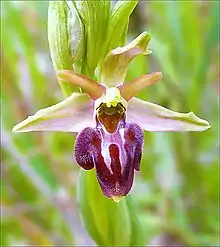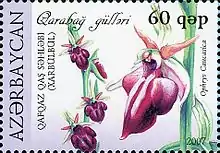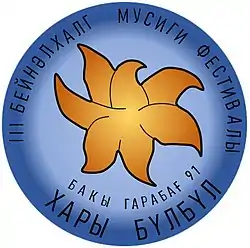Ophrys caucasica
Ophrys caucasica (Armenian: Սարդակիր Մեղվակիր, romanized: Sardakir mexvakir, Azerbaijani: xarı-bülbül, Georgian: ფუტკრის-დედა, romanized: put'k'ris-deda) is a species of orchid endemic to the Caucasus. It has been recorded in numerous areas throughout Armenia, Azerbaijan, Georgia and Russia.[1][2] The overall distribution of the species ranges from coastal massifs of north-east Anatolia, from Trabzon in the west, probably to the Caspian Sea.[3]
| Ophrys caucasica | |
|---|---|
 | |
| Scientific classification | |
| Kingdom: | |
| Order: | |
| Family: | |
| Genus: | |
| Species: | O. caucasica |
| Binomial name | |
| Ophrys caucasica | |
According to the IUCN Red List, the category and status of the species is "Endangered" – EN B1ab(iii)+2ab(iii).
Characteristics
During various growth stages of the Ophrys caucasica, it's white petals turn into pink, where various colors (green, yellow, red, etc.) merge together. There are also patterns on the part below the bottom of the Ophrys caucasica.[4]
Local etymology
In Armenian, its native name (sardakir mexvakir) refers to its primary pollinators, spiders (sard) and bees (mexu) and their food (kir).
Khara in Azerbaijani is a thick and shiny fabric with different patterns on it , that changes its colors when look at from different angles. Because of these characteristics Ophrys caucasica got its Azerbaijani name, which translates as "khara nightingale". The spelling of the word khara becomes khari by requirement of the law of harmony in Azerbaijani.[5]
Culture


In 2014 an exhibition titled "Khari bulbul, a flower of peace and love" was organized by the Federal National Cultural Autonomy of Azerbaijanis in Russia.[6] In March, 2014 a presentation ceremony of Ophrys caucasica took place in the United States Botanic Garden Conservatory.[7]
References
- "Studies on the botanical and ecological aspects of a rare species Ophrys caucasica from Azerbaijan (Orchidaceae)". Researchgate. October 2019. Retrieved 12 November 2020.
- "Georgian Biodiversity Database". biodiversity-georgia.net. Retrieved 2020-11-12.
- Delforge, Pierre (2006). Orchids of Europe, North Africa and the Middle East - 3rd edition (revised and enlarged). London: A&C Black. p. 563. ISBN 0-7136-7525-X.
- Huseyinoghlu, Kamil (8 April 2022). ""Xarı bülbül" adının mənası". Axar. Retrieved 12 March 2023.
- "The meaning of the word Khari Bulbul". Karabakh Foundation. Retrieved 12 March 2023.
- "'Khari Bulbul - a flower of peace and love' exhibition due in Moscow". Today.az. 4 August 2014. Retrieved 12 May 2017.
- Rajabova, Sara (19 March 2014). "Karabakh's Khari Bulbul presented in U.S." Azernews. Retrieved 12 May 2017.
External links
- Hari bulbul – the flower of peace and love
- The meaning of the word khari bulbul
- Alibeyli, Jamil (Summer 1998). "Susha: Heartbeat of Karabakh". Azerbaijan International. 6 (2): 52–54.